ABOUT LAXEY VILLAGE AND ITS HISTORY
Laxey village is situated on the east coast of the Isle of Man. The village extends for just over 2 kilometres from the mine workings in its upper reaches – identifiable by the famous Laxey Wheel, along the steep sided glen in a south easterly direction, to the picturesque and unspoilt tiny harbour at the North end of a wide bay. It is from here i.e. ‘Old Laxey’ the original historic settlement of fishermen’s crofts that the village has evolved.
The Great Laxey Mine
The Laxey mine was extensive and at its peak the Great Laxey Mining Company employed over 600 miners. Consequently the mining company became responsible for the establishment and development of much of the village as it exists to this day.
During this time, two main areas were developed. First being the harbour area: used to bring in supplies as well as transporting the lead and zinc from the mines off Island, and secondly along the valley towards the main mining areas, located about a mile inland from the harbour.
In addition a number of larger properties were constructed on the hills around the valley, these were typically the homes of the managers and supervisors who ran and operated the mine, many of which are identified as part of the Heritage Trail.The Great Laxey Mine Railway
 Mining for lead and zinc began at Laxey in about 1780. By the mid 1870s the Great Laxey Mine was one of the richest and most successful metal mines in Britain. Shafts had been sunk to depths of over 2000 feet deep and nearly 1000 men, together with a few women and young lads, worked at the mine.
Mining for lead and zinc began at Laxey in about 1780. By the mid 1870s the Great Laxey Mine was one of the richest and most successful metal mines in Britain. Shafts had been sunk to depths of over 2000 feet deep and nearly 1000 men, together with a few women and young lads, worked at the mine.
The main level of the mine was known as the Adit Level. It entered the hillside beneath the Laxey Wheel, connecting with each of the shafts deep underground and having a maximum length of nearly 1 1/2 miles. A tramway ran along the entire length of the adit level and was used to carry the mined ore out of the mine to the Washing Floors where the ore was prepared for sale.
The tramway wagons were originally hauled by ponies but in 1877 they were replaced by two 19 inch gauge steam locomotives built by Stephen Lewin of Poole, Dorset. Named Ant and Bee they remained in use until the mine closed in 1929 and were broken up for scrap a few years later.
In 1999, the Laxey and Lonan Heritage Trust began the restoration of the surface section of the former tramway. A bequest from the estate of the late Lt Col R S Glenn funded the building of two fully working replicas of the original Ant and Bee. The restored Great Laxey Mine Railway was officially opened on 25th September, 2004. Passengers can now ride in a tiny carriage along the line where loaded wagons of ore were once hauled from the mine.
The railway, a quarter of a mile in length, runs up the valley from the former Washing Floors, now the Valley Gardens, to the main adit entrance where there is a picnic site, footpath and information boards explaining the mining features. The Laxey Wheel is only a short walk away.
The line runs beneath the main Laxey to Ramsey road and the Manx Electric Railway through the longest railway tunnel on the Island! Steam trains normally run on Saturdays and Bank Holidays, from Easter until the end of September. Please check with Laxey Tourist Information for further details.
The Laxey Wheel
The Laxey Wheel was designed by Manx engineer Robert Casement. The wheel’s axle was forged by the Mersey Iron Works of Liverpool but the cast iron rims were made on the Island by Gelling’s Foundry at Douglas. The timbers of the wheel were shaped by Manx artisans and the whole structure was assembled here on the Island. The wheel has a diameter of over 22 metres, (72 feet 6 inches), and a width of 1.8 metres (6 feet). It is capable of pumping 1136 litres (250 gallons) of water per minute from a depth of almost 457.2 metres (1,500 feet).
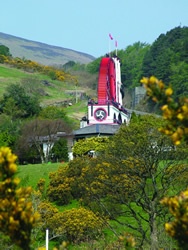 The mine shaft from which the water was pumped was sited about 410 metres (450 yards) from the great wheel. The power from the wheel was transmitted to the pumping mechanism by a series of rods supported by and running along an imposing masonry viaduct. The official opening of this huge wheel took place in September 1854 when the Wheel was set in motion by the Honourable Charles Hope, the Lieutenant Governor of the Island. The wheel was named ‘Lady Isabella’ in honour of the Governor’s wife. The 150th anniversary of the Lady Isabella was celebrated in 2004 when a re-enactment of the original ceremony took place at the Wheel.
The mine shaft from which the water was pumped was sited about 410 metres (450 yards) from the great wheel. The power from the wheel was transmitted to the pumping mechanism by a series of rods supported by and running along an imposing masonry viaduct. The official opening of this huge wheel took place in September 1854 when the Wheel was set in motion by the Honourable Charles Hope, the Lieutenant Governor of the Island. The wheel was named ‘Lady Isabella’ in honour of the Governor’s wife. The 150th anniversary of the Lady Isabella was celebrated in 2004 when a re-enactment of the original ceremony took place at the Wheel.
Since 1989 The Lady Isabella has been administered by Manx National Heritage and is a fantastic starting point for the ‘Heritage Trail’.
Old Washing Floors
An essential part of the mining process was the separation of the waste stone from the precious ores in preparation for its transportation to the market place. These processes were carried out on the area known as the ‘washing floors’. The entire ‘dressing’ process was carried out by water power and four water wheels operated in this area, driving machinery known as ‘jiggers, crushers & buddles’.
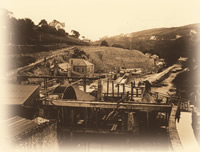 During the peak years of production over 300 people (men, women & boys) worked on the washing floors preparing the ore for shipment. Although much of the machinery was dismantled following the Second World War, there are still many areas of interest & clues to the former use of the site.
During the peak years of production over 300 people (men, women & boys) worked on the washing floors preparing the ore for shipment. Although much of the machinery was dismantled following the Second World War, there are still many areas of interest & clues to the former use of the site.
Ore was brought out of the mine in ore trucks, hauled by one of two steam engines named ‘Ant’ or ‘Bee’. The ore was tipped from the wagon down the stone chutes known as ‘teams’ into storage bunkers below where the ore awaited the first stage of the dressing process. During the 1870s the original set of teams were abandoned and new teams were constructed at the northern end of the washing floors at right angles to the original set.
Ore was taken from the teams to a grate, located near the position of the present stone stage area, to be thoroughly washed. The mixture of stone and ore was broken by hand into small pieces and tipped onto a large revolving wooden table known as the ‘chat’ table, where waste stone was hand picked and removed.
After undergoing a number of mechanical crushing processes the ore was tipped into the ‘jiggers’. These were, in their simplest form, large sieves into which the ore was placed and which were then vibrated in wooden boxes filled with water. The ‘jigging’ process caused the ores and remaining waste stone to separate into layers due to their differing densities. The waste stone removed from the chat table, crushers and jiggers was tipped next to the river, on the upstream side of the main road.
Eventually the heap of stones, known as ‘the deads’, towered over the houses of Dumbells Terrace. The deads remained a conspicuous feature of the Laxey valley until the Second World War. Some stone was removed to be used on a scheme to widen the northern end of Douglas Promenade. The vast majority of the stone was removed to be used as infill for the runway of the RAF station constructed at Jurby in the north of the Island. By 1943 the deads had all but disappeared.
The Snaefell Mine
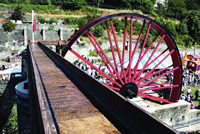 The Snaefell Mine was situated at the head of the Laxey Valley on the lower slope of Snaefell Mountain. The remains of the mine can be seen today from the tramcars of the Snaefell Mountain Railway as they climb towards the Bungalow station. In 1865 a 15.4 metre (501/2 feet) diameter waterwheel was built to pump water from the mine. It was supplied by L & G Howell of the Hawarden Ironworks in Flintshire.
The Snaefell Mine was situated at the head of the Laxey Valley on the lower slope of Snaefell Mountain. The remains of the mine can be seen today from the tramcars of the Snaefell Mountain Railway as they climb towards the Bungalow station. In 1865 a 15.4 metre (501/2 feet) diameter waterwheel was built to pump water from the mine. It was supplied by L & G Howell of the Hawarden Ironworks in Flintshire.
When the mine finally closed in 1908, the waterwheel was sold and then re-erected at Blisland in Cornwall, being used to pump slurry from a china clay pit. In the 1970s, the components of the wheel were preserved by the Trevithick Society and were stored for a number of years at a Welsh mining museum.
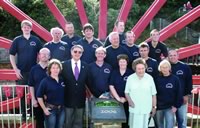 In 2003, the Laxey Mines Research Group, in conjunction with the Laxey and Lonan Heritage Trust, reached agreement with the Trevithick Society to return the components to Laxey and re-erect the waterwheel in the Valley Gardens, the former Great Laxey Mine washing floors. All the waterwheel components were fully refurbished, new woodwork was fashioned, a new water supply and aqueduct were constructed and a new footbridge placed over the river. An appeal to raise funds for the restoration proved very popular and the waterwheel was rebuilt and officially set in motion as Lady Evelyn on 20th August 2006. The restoration team together with Evelyn Jones whom the Wheel was named after are pictured left. For further details of the Snaefell Waterwheel, log onto www.snaefellwheel.com
In 2003, the Laxey Mines Research Group, in conjunction with the Laxey and Lonan Heritage Trust, reached agreement with the Trevithick Society to return the components to Laxey and re-erect the waterwheel in the Valley Gardens, the former Great Laxey Mine washing floors. All the waterwheel components were fully refurbished, new woodwork was fashioned, a new water supply and aqueduct were constructed and a new footbridge placed over the river. An appeal to raise funds for the restoration proved very popular and the waterwheel was rebuilt and officially set in motion as Lady Evelyn on 20th August 2006. The restoration team together with Evelyn Jones whom the Wheel was named after are pictured left. For further details of the Snaefell Waterwheel, log onto www.snaefellwheel.com
Old Laxey
Old Laxey is on a little flat between steep heights at the mouth of the Laxey River. Today the original village centre is a popular spot for visitors. The promenade area is quite undeveloped and the bay offers a long stretch of sandy beach and dozens of rock pools for exploration. During the summer months young people enjoy swimming out to the wooden raft shackled to the foreshore. Following the zig zag path from the southern end of the promenade and continuing over Old Laxey Hill one can pick up the electric railway at ‘South Cape’ stop.
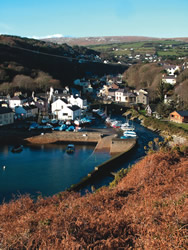 From Laxey Headland one can access the Raad Ny Foillan – the way of the gull which is clearly marked with the gull on a blue sign. This long distance coastal walk of some 95 miles can be walked in 5 days though you might want to allow a bit longer.
From Laxey Headland one can access the Raad Ny Foillan – the way of the gull which is clearly marked with the gull on a blue sign. This long distance coastal walk of some 95 miles can be walked in 5 days though you might want to allow a bit longer.
Perhaps the best views of Old Laxey are obtained by approaching from the sea. During the summer months the Island’s largest coastal passenger vessel – the traditional m.v. Karina operates cruises to Laxey Harbour. The Karina which is included on the prestigious National Maritime Museum’s register of historic ships regularly departs from Douglas for a 3 hour return trip to the seaside village of Old Laxey. The cruise passes many famous landmarks including the Tower of Refuge, Derby Castle, Onchan Head, Groudle Glen, Clay head, Garwick Cove then across the bay to Laxey Harbour. Most of the way you will see magnificent cliffs with marine and bird life. The return trip allows about one hour ashore at picturesque Laxey.
Laxa´
The village links with our Viking friends indicates that Laxey was a bountiful stopping off place. “Laxey” comes from the old Norse “laxa” (a in Old Norse means river and is common in the Island, whilst “lax” means salmon.)
 The name originally denoted the river and not the settlement but the two have come to mean the same. Salmon migrate upstream from Laxey harbour favouring the Glen Roy tributary (at its junction opposite the Woollen Mill). The stone footbridge within Laxey Glen is a good vantage point from which to observe the salmon making this arduous journey in late evening during the autumn months. Spawning will take place in the area of Laxey Glen where the Department of Agriculture Fisheries and Forestry also maintain a salmon hatchery to boost the river stock. River fishing opens on 1st April through until the end of September for brown trout salmon and sea trout, with an extension to the end of October for migratory fish only. The ideal time to land salmon or sea trout is late summer / early autumn.
The name originally denoted the river and not the settlement but the two have come to mean the same. Salmon migrate upstream from Laxey harbour favouring the Glen Roy tributary (at its junction opposite the Woollen Mill). The stone footbridge within Laxey Glen is a good vantage point from which to observe the salmon making this arduous journey in late evening during the autumn months. Spawning will take place in the area of Laxey Glen where the Department of Agriculture Fisheries and Forestry also maintain a salmon hatchery to boost the river stock. River fishing opens on 1st April through until the end of September for brown trout salmon and sea trout, with an extension to the end of October for migratory fish only. The ideal time to land salmon or sea trout is late summer / early autumn.
 Licences, required for fishing all inland waters, are available from the Post offices, tackle shops, or the Department of Agriculture Fisheries and Forestry who manage the Laxey Glen.
Licences, required for fishing all inland waters, are available from the Post offices, tackle shops, or the Department of Agriculture Fisheries and Forestry who manage the Laxey Glen.
Laxey Fair. This annual event is held on the last Saturday of June. Traditionally regional fairs were held on the feast day of the local saint, and were preceded by a church service in the early morning.
Laxey fair was one of these, the most important one in this part of the Island, held on St Lonan’s Day (August 5th) at the foot of the river meadows, where the harbour is now. It continued well into the 19th century when, with the expansion of the mines, it was gradually crowded out and it lapsed for many years.
The revival of the Laxey Fair in the location of the “Old Washing Floors” is again a well attended annual event, the local schoolchildren parade in costume acknowledging the village’s mining heritage.
King Orry’s Grave
The largest known megalithic tomb on the island lies in the garden of a private cottage. The Cairn (a conical heap of stones built as a monument or a landmark grave) is made of coloured sandstone with a forecourt of 12 metres across and 4 metres deep. It contains three chambers once filled with burials, when excavated only one burial and bowl survived.
King Orry’s Grave, as it is commonly known, tells something of the residents who lived on the Isle of Man during the Neolithic times over 4000 years ago. The site was built by farmers as a memorial to their ancestors. Ceremonies held on the site left traces of hearth and flint. This burial place dates from long before the period of the Orry Kings, who were buried at Iona, Furness Abbey, and Rushen Abbey.
